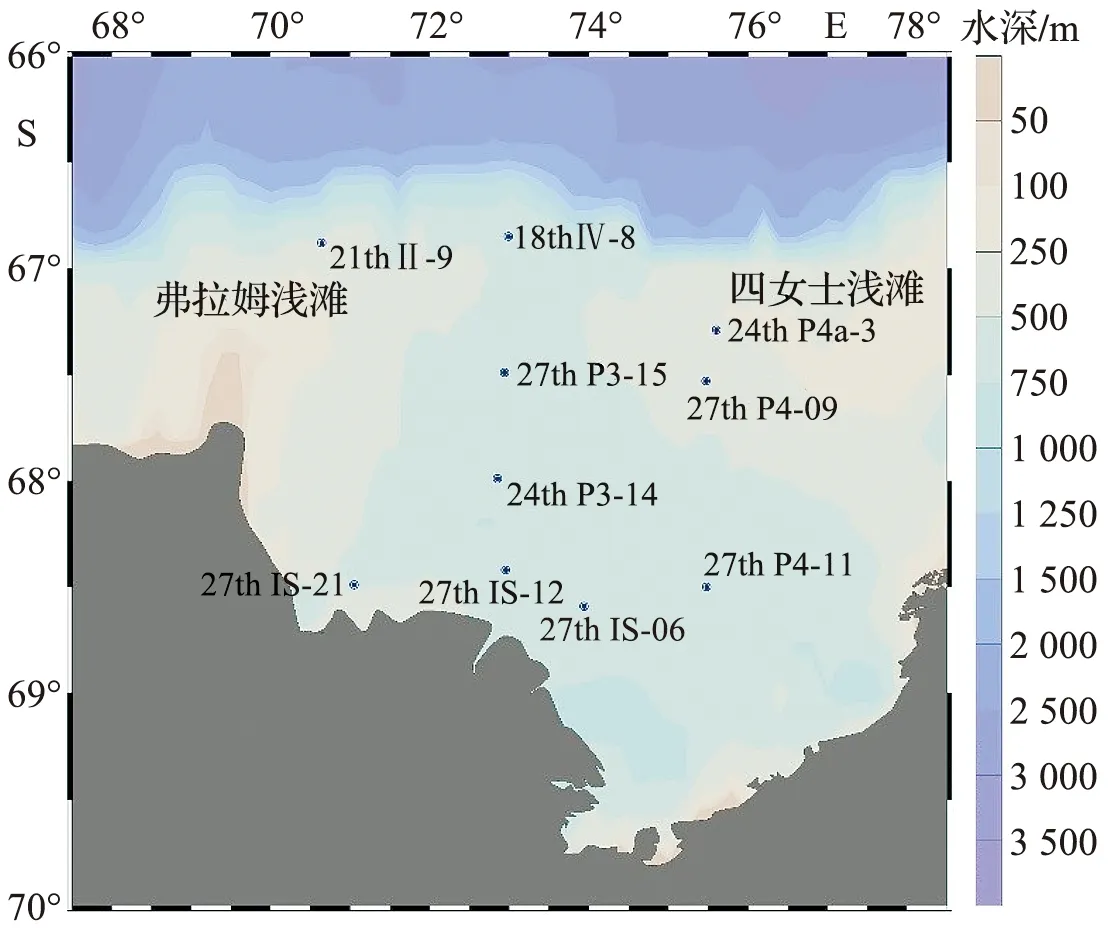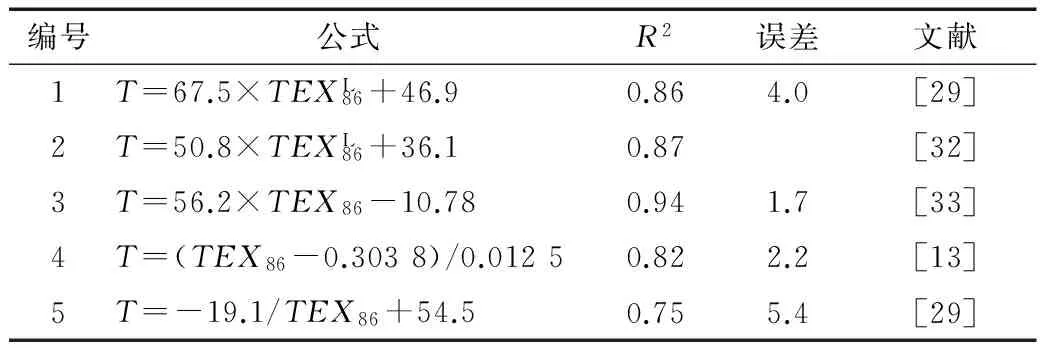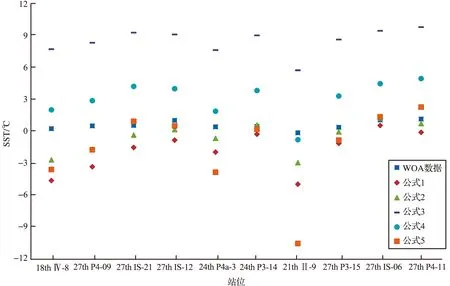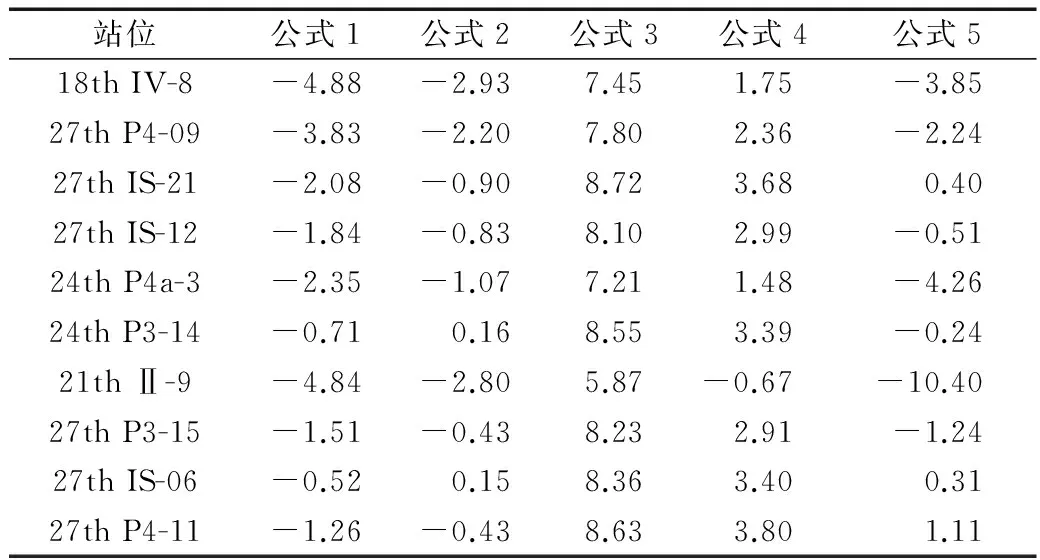南极普里兹湾表层沉积物GDGTs含量分布与TEX86指标应用研究
杨 峥,于培松,潘建明*,刘瑞娟,韩正兵,张海峰,胡 佶
(1. 国家海洋局 海洋生态系统与生物地球化学重点实验室,浙江 杭州 310012;2.国家海洋局 第二海洋研究所,浙江 杭州 310012)
南极普里兹湾表层沉积物GDGTs含量分布与TEX86指标应用研究
杨 峥1,2,于培松1,2,潘建明*1,2,刘瑞娟1,2,韩正兵1,2,张海峰1,2,胡 佶1,2
(1. 国家海洋局 海洋生态系统与生物地球化学重点实验室,浙江 杭州 310012;2.国家海洋局 第二海洋研究所,浙江 杭州 310012)

GDGTs;TEX86;普里兹湾;沉积物
0 引言
甘油双烷基甘油四醚(glycerol dialkyl glycerol tetraethers, GDGTs)是一种生物类脂物,存在于古菌和某些细菌中,广泛分布在全球海洋、湖泊的水体与沉积物,以及陆地土壤中[1-2]。从结构上,GDGTs可以分为类异戊二烯GDGTs(isoprenoid GDGTs,iGDGTs)和支链GDGTs(branched GDGTs,brGDGTs)两大类,这两类GDGTs在合成路径和生物化学性质等方面都存在一定的差别。
iGDGTs是古菌细胞膜的主要成分,实验室培养与现场采样分析,都显示出温度与GDGTs环戊烷的数目呈现良好的相关性,SCHOUTEN et al[3]依此提出了计算海表温度(SST)的TEX86(tetra ether index of tetraethers consisting of 86 carbon atoms)指标:
SST=(TEX86-0.28)/0.015 (R2=0.92)

brGDGTs广泛存在于土壤之中,它们的碳骨架不是类异戊二烯结构,而是具有数目不等的甲基支链,只有0~2个环戊烷结构,而且没有环己烷结构。虽然具体的系统发育地位尚不明确,但是brGDGTs通常是由土壤中的厌氧菌产生的[10]。所以brGDGTs在近海沉积物中的丰度可被用来定量指示土壤有机质向海洋系统的输入。HOPMANS et al[11]研究全球多个区域的海洋和湖泊沉积物、土壤和泥炭后,将海洋沉积物中brGDGTs的含量与iGDGTs 中泉古菌醇的含量之比定义为BIT (branched and isoprenoid tetraether)指标:
除了TEX86和BIT指标,GDGTs相关指标还有反映土壤pH的CBT(cyclization index of branched tetraethers)指标和反映平均大气温度及土壤pH的MBT(methylation index of branched tetraethers)指标[12]。
在极地海域,GDGTs的相关指标已经取得了一定的应用。SHEVENELL et al[13]利用TEX86指标在南极半岛反演了近12 000 a来的海表温度,发现海表温度的变化与日照时间对应,且海表温度与西风带位置相关。SLUIJS et al[14]利用 TEX86指标,重建了北冰洋新生代早期即古新世—始新世极热时期(PETM)表层海水温度。国内也有很多利用GDGTs重建古温度古环境的尝试,王寿刚 等[15]分析了白令海及西北冰洋采集的65个表层沉积物的GDGTs,发现从楚科奇海北部到高纬度区的阿尔法脊,陆源有机质相对比例有明显的增加,与有机碳稳定同位素等结果相同,表明BIT可以用来指示北极陆源有机质的输入变化。于晓果 等[16]分析了北冰洋11个站位的表层沉积物GDGTs的相关参数,发现楚科奇海域68°~73°N站位的TEX86-SST与年平均SST具有较好符合性而白令海TEX86-SST与夏季平均SST符合性更好,并认为这应该与古菌在不同海区不同的生长模式有关。
南极普里兹湾位于南大洋印度洋扇区,呈喇叭状,自东北向西南嵌入南极大陆,南面邻接埃默里冰架,其东端(70°S,76°E)靠近四女士浅滩,西端(68°S,69°E)靠近弗拉姆浅滩。普里兹湾是我国南极科考的重要海区,此前还未有人对普里兹湾的GDGTs进行过研究,本文旨在通过分析南极普里兹湾表层沉积物中的GDGTs,探讨TEX86与BIT等指标在该区域的应用前景。
1 材料与方法
1.1 样品采集
沉积物样品由“雪龙”号科考船在第18、21、24和27次南极科学考察中获取。共选取10个站位,覆盖了普里兹湾内区、埃默里冰架边缘区以及弗拉姆和四女士浅滩区等(图1)。样品主要来自箱式采样器,对箱式采样器中沉积物样品插管后取0~1 cm为表层样;少数站位来自多管采样器,多管沉积物现场分割,取0~1 cm为表层样。样品封装后冷冻带回实验室,进行相关参数的测定。

图1 普里兹湾表层沉积物采样站位Fig.1 Sampling stations of surface sediments in Prydz Bay
1.2 实验方法
称取6~10 g冻干研磨的沉积物样品,装入34 mL快速溶剂萃取仪(ASE-350)萃取池中,加入C46-GDGT标样,提取溶剂用二氯甲烷/甲醇(9∶1,v/v)混合溶剂,温度100 ℃加热5 min,静态提取15 min,静态循环2次,冲洗体积60%,吹扫时间60 s,萃取液收集到收集瓶中。萃取液经氢氧化钾-甲醇溶液水解后,过硅胶柱分离,以正己烷和甲醇进行洗脱,分别获得极性组分和非极性组分。极性组分过0.45 μm PETF滤膜,使用UPLC-MS/MS分析GDGTs。
GDGTs分析采用超高效液相色谱质谱联用仪(Waters Acquity UPLC Xevo TQ MS/MS),液相色谱柱采用waters 公司HSS Cyano (2.1×150 mm,1.8 μm)柱, 进样体积2 μL。质谱条件:化合物在大气压化学电离源(APCI)中进行离子化,离子源温度150 ℃,探针温度550 ℃,锥孔气体流速100 L/h,脱溶剂气体流速1 000 L/h,碰撞气体流速0.15 mL/min。实验时为了提高灵敏度和重现性,采用单离子检测(single ion monitoring,SIM)模式进行扫描,最后通过内标含量和各峰面积比值确定各化合物含量。
2 结果与讨论
2.1 GDGTs的含量与分布
普里兹湾海域表层沉积物样品中GDGTs含量为27.69~900.78 ng/g,iGDGTs在总GDGTs含量中占到了94%以上,远高于brGDGTs。iGDGTs含量范围为27.36~858.47 ng/g,平均值为348.09 ng/g;brGDGTs含量范围为0.32~42.31 ng/g,平均值为16.07 ng/g。各站位iGDGTs都以GDGT-0和泉古菌醇为主,含量范围分别为15.90~499.30 ng/g和10.52~330.51 ng/g。GDGT-1~3的含量范围都为0.07~18.19 ng/g,总共只占iGDGTs含量的3%。brGDGTs中,GDGT-Ⅰa(平均4.41 ng/g)和GDGT-Ⅱb(平均4.74 ng/g)略多于其他几种,GDGT-Ⅰc(平均0.55 ng/g)和GDGT-Ⅲc(平均0.44 ng/g)含量较低,其余几种差异不大(平均1.08~1.37 ng/g)。
GDGTs最高值出现在东南角的P4-11站位,最低值出现在西北角的Ⅱ-9站位。整体呈现从东南到西北逐渐减小的趋势。iGDGTs和brGDGTs的分布模式与总GDGTs相同,呈现从东南到西北逐渐减小的趋势(图2)。

图2 普里兹湾表层沉积物中GDGTs与TOC分布Fig.2 Distributions of GDGTs and TOC in surface sediments of Prydz Bay
2.2 BIT与GDGTs来源分析
BIT作为陆源有机质与海源有机质的参考比值,在全球范围内得到了广泛应用。普里兹湾Ⅱ-9站位BIT值为0.01,P4-09站位BIT值为0.08,其余各站都在0.04~0.06之间,差别较小。BIT表征陆源土壤有机碳(OC)输入有一定的限制,因为BIT的成立有2个基本假设,首先泉古菌醇的含量和海源OC共变,另外一点是,brGDGTs来源于陆地OC土壤的输入。
iGDGTs含量与TOC和泥质含量都呈现了良好的相关性,表现出极好的对应关系(表1和表2,本文所涉及的相关性分析全部使用SPSS 19.0软件进行Pearson相关性分析)。中国南极考察多年来的实际调查显示,海水叶绿素a、初级生产力、浮游植物细胞丰度等均以普里兹湾湾内中心区域最高,这主要是由于每年夏季,湾中心区域的海冰最先融化而成为开阔水域,而且中心区域水体稳定,比较适合浮游植物的生长[18-20]。普里兹湾沉积物中OC主要来源于水生浮游植物,其受上层水体初级生产的控制,因此湾中心区域的TOC含量最高。西部OC含量较低主要是因为大量陆源砂的稀释作用[17]。因此iGDGTs和TOC等参数良好的相关性可能是源于水生古菌的生长需要依赖初级生产提供的有机质作为其能量来源。

表1 普里兹湾表层沉积物TOC、泥质和GDGTs含量数据Tab.1 Contents of TOC、mud and GDGTs in surface sediments of Prydz Bay
注:表中空白处表示无数据。
泉古菌醇及其异构体通常被认为是水生Thaumarchaeota特有的标志物,GDGT-0在除嗜盐古菌外的所有古菌中广泛分布,而GDGT-1~3通常由(超)嗜热泉古菌中超嗜热广古菌门合成[1]。对各站位iGDGT单体进行的相关性分析显示,5种iGDGT都呈现显著的正相关(0.987 brGDGTs通常由土壤中的厌氧细菌产生,但是海洋沉积物中brGDGTs来源无法直接确定,因为不仅是陆地土壤,海洋沉积物中也有可以产生brGDGTs的细菌存在。通常相对于土壤输入,海底沉积物自生的brGDGTs含量较小,可以忽略[22]。但普里兹湾表层沉积物中brGDGTs含量较低,沉积物中细菌自生的brGDGTs可能占有较大比重。 普里兹湾brGDGTs含量与iGDGTs含量呈现了非常好的相关性。这种情况在中国南黄海与地中海沿岸等地区都有出现[23-24]。GE et al[23]认为河口区大量陆源营养物质的输入可能会促进初级生产力的增长,因而造成iGDGTs含量随着brGDGTs的增加而增长。但是普里兹湾为高营养盐低生产力海域,不存在营养盐的限制,陆源营养物质的输入应该不会具有决定性的影响。因此,普里兹湾表层沉积物中brGDGTs很有可能是沉积物中原生的厌氧细菌产生的,而非来源于陆源土壤。因为土壤中的细菌以沉积物中OC为主要碳源,所以brGDGTs的含量与OC和泥质含量有较好的相关性。 表2 普里兹湾表层沉积物部分参数相关性Tab.2 Correlation of some parameters in surface sediments of Prydz Bay 注:*表示在 0.05 水平(双侧)上显著相关,**表示在0.01 水平(双侧)上显著相关。 2.3 TEX86与SST 并提出了多个相关公式。这一研究为TEX86在极地的应用创造了条件。由于不同区域GDGTs分子对于温度的响应并不完全相同,研究人员在不同海域提出了多个相关公式。表3中为已经在南北极取得应用的一些公式。 表3 极地海域TEX86-SST计算公式Tab.3 Calibration models between TEX86 and SST used in the polar sea 图3 普里兹湾1月WOA-SST与TEX86-SSTFig.1 WOA-SST and TEX86-SST of Prydz Bay in January 站位公式1公式2公式3公式4公式518thIV-8-4.88-2.937.451.75-3.8527thP4-09-3.83-2.207.802.36-2.2427thIS-21-2.08-0.908.723.680.4027thIS-12-1.84-0.838.102.99-0.5124thP4a-3-2.35-1.077.211.48-4.2624thP3-14-0.710.168.553.39-0.2421thⅡ-9-4.84-2.805.87-0.67-10.4027thP3-15-1.51-0.438.232.91-1.2427thIS-06-0.520.158.363.400.3127thP4-11-1.26-0.438.633.801.11 利用中国南极考察获取的沉积物样品,对普里兹湾10个表层沉积物中GDGTs的含量与分布进行分析得出了以下几点结论: (1)普里兹湾表层沉积物iGDGTs与brGDGTs的含量分布模式相同,呈现南高北低的分布趋势,其中东南区域最高而西北区域最低。GDGTs含量与TOC及泥质含量呈现良好的正相关,表明表层GDGTs的含量可能主要是由生物生产主导,同时受到冰川携带的陆源砂稀释作用的影响。 (2)普里兹湾表层沉积物iGDGTs可能来源于水生古菌。brGDGTs可能主要来源于沉积物中原生细菌,而非通常认为的陆地土壤细菌。因此常用来指示陆源土壤OC输入的BIT指标在普里兹湾区域可能并不适用。 [1] SCHOUTEN S, HOPMANS E C, SINNINGHE DAMSTÉJ S. The organic geochemistry of glycerol dialkyl glycerol tetraether lipids: A review[J].Organic Geochemistry,2013,54(1):19-61. [2]SCHOUTEN S, VAN DER MEER M T, HOPMANS E C, et al. Archaeal and bacterial glycerol dialkyl glycerol tetraether lipids in hot springs of yellowstone national park[J]. Appled and Environmental Microbiology,2007,73(19):6 181-6 191. [3]SCHOUTEN S. Distributional variations in marine crenarchaeotal membrane lipids: a new tool for reconstructing ancient sea water temperatures[J]? Earth & Planetary Science Letters,2003,204(1-2):265-274. [4]SCHOUTEN S, HOPMANS E C, SINNINGHE DDAMSTÉJ S. The effect of maturity and depositional redox conditions on archaeal tetraether lipid palaeothermometry[J].Organic Geochemistry,2004,35(5):567-71. [5]WUCHTER C, SCHOUTEN S, COOLEN M J, et al. Temperature-dependent variation in the distribution of tetraether membrane lipids of marine Crenarchaeota: Implications for TEX86 paleothermometry[J].Paleoceanography,2004,19(4):1 537-1 546. [6]SCHOUTEN S, HOPMANS E C, FORSTER A, et al. Extremely high sea-surface temperatures at low latitudes during the middle Cretaceous as revealed by archaeal membrane lipids[J].Geology,2003,31(12):1 069-1 072. [7]HUGUET C, KIM J H, SINNINGHE DDAMSTÉJ S, et al. Reconstruction of sea surface temperature variations in the Arabian Sea over the last 23 kyr using organic proxies (TEX86and)[J].Paleoceanography,2006,21(1):279-298. [8]SCHOUTEN S, WAKEHAM S G, HOPMANS E C, et al. Biogeochemical evidence that thermophilic archaea Mediate the Anaerobic Oxidation of Methane[J].Applied and Environmental Microbiology,2003,69(3):1 680-1 686. [9]POWERS L A, WERNE J P, JOHNSON T C, et al. Crenarchaeotal membrane lipids in lake sediments: A new paleotemperature proxy for continental paleoclimate reconstruction[J]? Geology,2004,32(7):613-616. [10] WEIJERS J W, SCHOUTEN S, HOPMANS E C, et al. Membrane lipids of mesophilic anaerobic bacteria thriving in peats have typical archaeal traits[J].Environ Microbiol,2006,8(4):648-657. [11]HOPMANS E C, WEIJERS J W H, SCHEFUβ E, et al. A novel proxy for terrestrial organic matter in sediments based on branched and isoprenoid tetraether lipids[J].Earth and Planetary Science Letters,2004,224(1-2):107-116. [12]WEIJERS J W H, SCHOUTEN S, VAN DEN DONKER J C, et al. Environmental controls on bacterial tetraether membrane lipid distribution in soils[J].Geochimica et Cosmochimica Acta,2007,71(3):703-713. [13]SHEVENELL A E, INGALLS A E, DOMACK E W, et al. Holocene Southern Ocean surface temperature variability west of the Antarctic Peninsula[J].Nature,2011,470(7333):250-254. [14]SLUIJS A, SCHOUTEN S, PAGANI M, et al. Subtropical Arctic Ocean temperatures during the Palaeocene/Eocene thermal maximum[J].Nature,2006,441(7093):610-613. [15]WANG Shou-gang,WANG Ru-jian,CHEN Jian-fang,et al.Spatial distribution patterns of GDGTs in the surface sediments from the Bering Sea and Arctic Ocean and their environmental significances[J]. Advances in Earth Science,2013,28(2):282-296. 王寿刚,王汝建,陈建芳,等.白令海与西北冰洋表层沉积物中四醚膜类脂物研究及其生态和环境指示意义[J].地球科学进展,2013,28(2):282-295. [16]YU Xiao-guo, BIAN Ye-ping, RUAN Xiao-yan, et al. Glycerol dialkyl glycerol tetraethers and TEX86 index in surface sediments of the arctic ocean and the Bering sea[J]Marine Geology & Quaternary Geology,2015,35(3):11-22. 于晓果,边叶萍,阮小燕,等.北冰洋沉积物中四醚脂类来源与TEX86指数初步研究[J].海洋地质与第四纪地质,2015,35(3):11-22. [17]LIU Rui-juan, YU Pei-song, HU Chuan-yu, et al. Contents and distributions of organic carbon and total nitrogen in sediments of Prydz Bay, Antarctic[J].Acta Oceanolgica Sinica(in Chinese),2014,36(4):118-125. 刘瑞娟,于培松,扈传昱,等.南极普里兹湾沉积物中有机碳和总氮的含量与分布[J].海洋学报,2014,36(4):118-125. [18]LIU Zi-lin, SHI Jun-xian, CHEN Zhong-yuan, et al. Distributions of phytoplankton, size-fractionated chlorophyll a and primary productivity in Prydz bay and the adjacent area during Austral summer[J]. Chinese Journal of Polar Research,1997,9(1):18-27. 刘子琳,史君贤,陈忠元,等.南极夏季普里兹湾邻近海域浮游植物,粒度分级叶绿素a和初级生产力的分布[J].极地研究,1997,9(1):18-27. [19]LIU Cheng-gang, NING Xiu-ren, SUN Jun, et al. Size structure of standing stock and productivity and new production of phytoplankton in the Prydz Bay and the adjacent Indian sector of the Southern Ocean during the austral summer of 2001/ 2002[J]. Acta Oceanolgica Sinica(in Chinese),2004,26(6):107-117. 刘诚刚,宁修仁,孙军,等.2002年夏季南极普里兹湾及其邻近海域浮游植物现存量,初级生产力粒级结构和新生产力研究[J].海洋学报,2004,26(6):107-117. [20]JIN Si-yun, PAN Jian-ming, HAN Zheng-bing. Spatial and temporal variability of chlorophyll during the austral summer in Prydz bay, Antarctic[J]. Chinese Journal of Polarresearch, 2012,24(4):361-371. 金思韵,潘建明,韩正兵.南极夏季普里兹湾叶绿素a的时空变化研究[J].极地研究,2012,24(4):361-371. [21]WUCHTER C, ABBAS B, COOLEN M J, et al. Archaeal nitrification in the ocean[J].Proceedings of the National Academy of Sciences,2006,103(33):12 317-12 322. [22]PETERSE F, KIM J-H, SCHOUTEN S, et al. Constraints on the application of the MBT/CBT palaeothermometer at high latitude environments (Svalbard, Norway)[J].Organic Geochemistry,2009,40(6):692-699. [23]GE H, ZHANG C L, LI J, et al. Tetraether lipids from the southern Yellow Sea of China: Implications for the variability of East Asia Winter Monsoon in the Holocene[J].Organic Geochemistry,2014,70(5):10-9. [24]GRAUEL A-L, LEIDER A, GOUDEAU M-L S, et al. What do SST proxies really tell us? A high-resolution multiproxystudy in the Gulf of Taranto, central Mediterranean Sea[J].Quaternary Science Reviews,2013,73:115-131. [25]MENZEL D, HOPMANS E C, SCHOUTEN S, et al. Membrane tetraether lipids of planktonic Crenarchaeota in Pliocene sapropels of the eastern Mediterranean Sea[J].Palaeogeography, Palaeoclimatology, Palaeoecology,2006,239(1-2):1-15. [26]HUGUET C, SCHIMMELMANN A, THUNELL R, et al. A study of the TEX86 paleothermometer in the water column and sediments of the Santa Barbara Basin, California[J].Paleoceanography,2007,22(3): doi: 10.1029/2006PA001310. [27]SINNINGHE DAMSTÉJ S, RIJPSTRA W I C, HOPMANS E C, et al. Distribution of Membrane Lipids of Planktonic Crenarchaeota in the Arabian Sea[J].Applied and Environmental Microbiology,2002,68(6):2 997-3 002. [28]PARK Y-H, YAMAMOTO M, NAM S-I, et al. Distribution, source and transportation of glycerol dialkyl glycerol tetraethers in surface sediments from the western Arctic Ocean and the northern Bering Sea[J].Marine Chemistry,2014,165:10-24. [29]KIM J-H, VAN DER MEER J, SCHOUTEN S, et al. New indices and calibrations derived from the distribution of crenarchaeal isoprenoid tetraether lipids: Implications for past sea surface temperature reconstructions[J].Geochimica et Cosmochimica Acta,2010,74(16):4 639-4 654. [30]GAO Guo-ping, DONG Zhao-qian, SHI Mao-chong. Variation of hydrographic feature along 73°E section near Prydz Bay[J].Journal of Ocean University of Qingdao, 2003,33(4):493-502. 高郭平,董兆乾,侍茂崇.南极普里兹湾附近73°E断面水文结构及多年变化[J].青岛海洋大学学报,2003,33(4):493-502. [31]ZHANG Hai-sheng, HU Chuan-yu, PAN Jian-ming, et al. Seasonal variability in deep ocean particle fluxes in the north open sea of Prydz Bay[J].Geochimica,2003,32(4):358-362. 张海生,扈传昱,潘建明,等.南极普里兹湾北部深海沉降颗粒物通量的季节性变化[J].地球化学,2003,32(4):358-362. [32]ETOURNEAU J, COLLINS L G, WILLMOTT V, et al. Holocene climate variations in the western Antarctic Peninsula: evidence for sea ice extent predominantly controlled by changes in insolation and ENSO variability[J].Climate of the Past,2013,9(4):1 431-1 446. [33]KIM J-H, SCHOUTEN S, HOPMANS E C, et al. Global sediment core-top calibration of the TEX86 paleothermometer in the ocean[J].Geochimica et Cosmochimica Acta,2008,72(4):1 154-1 173. Contents and distribution of GDGTs and the index application of TEX86in surface sediments of Prydz Bay, Antarctic YANG Zheng1,2, YU Pei-song1,2, PAN Jian-ming*1,2, LIU Rui-juan1,2,HAN Zheng-bing1,2, ZHANG Hai-feng1,2, HU Ji1,2 (1.LaboratoryofMarineEcosystemandBiogeochemistry,SOA,Hangzhou310012,China;2.SecondInstituteofOceanography,SOA,Hangzhou310012,China) The contents and distribution of glycerol dialkyl glycerol tetraethers (GDGTs) were analyzed for ten surface sediments from Prydz Bay of Antarctic. The results show that the contents of GDGTs are 27.69~900.78 ng/g with the isoprenoid GDGTs accounts for 94% ~99%, much more higher than branched GDGTs. Isoprenoid and branched GDGTs have same distribution tendency that the highest content area appears in southeast while the lowest area appears in northwest direction. Isoprenoid GDGTs and branched GDGTs both have obvious positive correlation with TOC. Analysis shows that isoprenoid GDGTs comes from marine Archaea, while branched GDGTs derives from bacteria in sediments. Compared with the WOA database, thederived temperatures are consistent with the sea surface temperatures in January in the study area. This study meansindexes could be applied to reconstruct the paleotemperature in Prydz Bay. GDGTs;TEX86;Prydz Bay;sediments 10.3969/j.issn.1001-909X.2017.01.006. 2016-04-11 2016-05-17 国家自然科学基金项目资助(41376193,41506223) 杨峥(1991-),男,湖北荆州市人,主要从事海洋生物地球化学方面的研究。E-mail:yangzheng@igge.cn *通讯作者:潘建明(1964-),男,研究员,主要从事海洋生物地球化学方面的研究。E-mail:jmpan@hzcnc.com P736.4+1 A 1001-909X(2017)01-0047-08 10.3969/j.issn.1001-909X.2017.01.006 杨峥,于培松,潘建明,等.南极普里兹湾表层沉积物GDGTs含量分布与TEX86指标应用研究[J].海洋学研究,2017,35(1):47-54, YANG Zheng, YU Pei-song, PAN Jian-ming, et al. Contents and distribution of GDGTs and the index application of TEX86in surface sediments of Prydz Bay, Antarctic[J].Journal of Marine Sciences,2017,35(1):47-54, doi:10.3969/j.issn.1001-909X.2017.01.006.






3 结论


